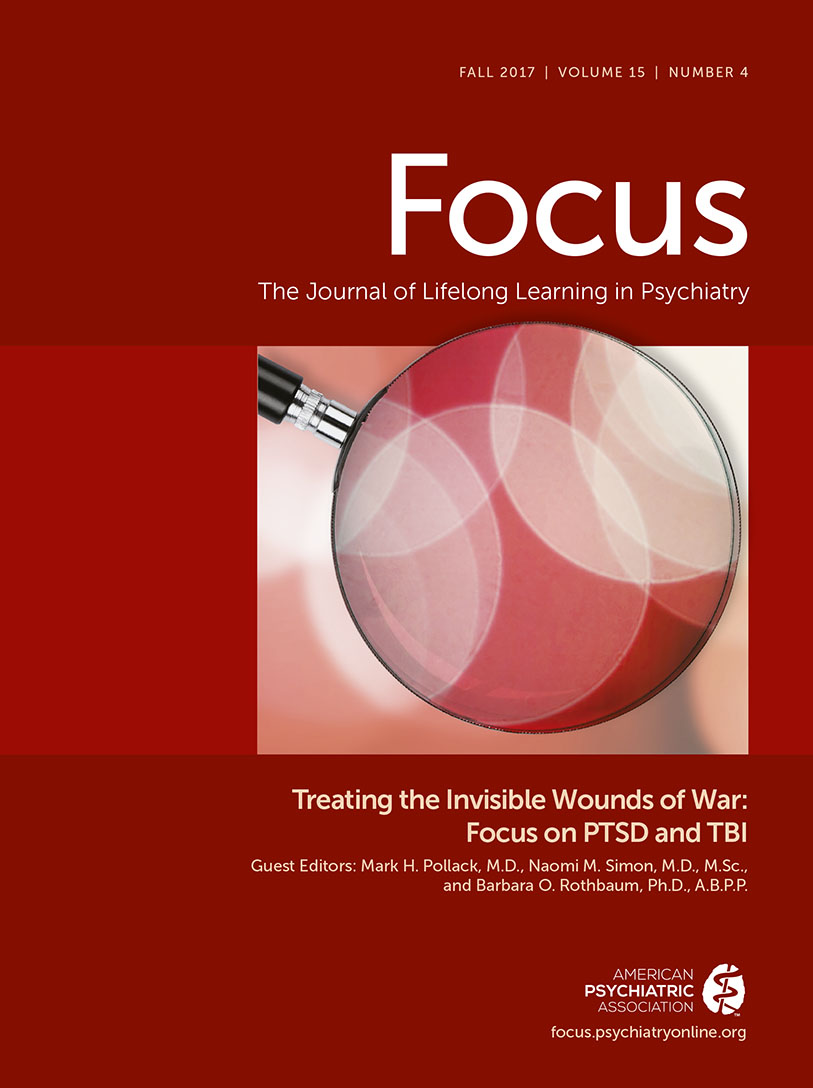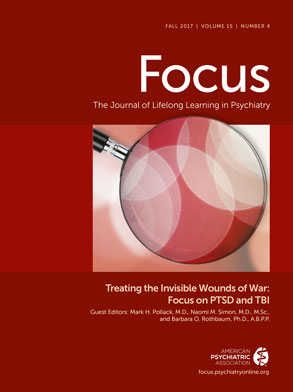Empirical support for concerns about the safety of exposure therapy for PTSD is limited. Based on six Vietnam veterans unsuccessfully treated with imaginal exposure, Pitman et al.
[5] suggested it is not suitable for patients displaying negative emotions other than anxiety (e.g. anger) and that cognitive approaches may be more beneficial for such patients. Tarrier et al.
[6] compared imaginal exposure with cognitive therapy and found that on average both treatments were similarly effective at decreasing PTSD symptoms. The authors reported that a significantly greater number of patients receiving imaginal exposure worsened over treatment (31 vs. 9.1%), with symptom worsening defined as an increase of one or more points on the Clinician Administered PTSD Scale (CAPS). At the 6-month follow-up assessment, however, no significant differences between groups emerged.
Devilly and Foa
[7] noted a number of methodological problems that complicate interpretation of the Tarrier et al.
[6] findings. First, they questioned the exclusive reliance on a single outcome measure (i.e. the CAPS) for defining symptom worsening when the study included other relevant measures (e.g. the Impact of Events Scale; the Penn Inventory for PTSD) on which no differential rates of worsening emerged. Second, given the measurement error associated with the CAPS, they questioned whether participants showing minimal increases in CAPS scores can be viewed as having experienced symptom worsening. To address these problems, Devilly and Foa
[7] proposed an alternative operational definition of symptom change, termed “reliable change,” that is based on the standard error of the differences between two administrations of the instrument (test–retest), so to assess for random fluctuations due to measurement error. Therefore, “reliable worsening” would be a pre- to posttreatment increase in symptoms larger than the standard error of the difference between two measurements. Third, as with Pitman et al.,
[4] the absence of a waitlist (WL) condition hampers interpretation of the Tarrier et al.
[6] results, because the percentage of patients who would experience symptom worsening without treatment is unknown.
In the present study, we examined whether prolonged exposure (PE), a specific exposure therapy protocol that combines imaginal and in vivo exposure, leads to PTSD symptom worsening using methodology that overcomes the limitations of previous studies. We accomplished this by pooling data from four published, well-controlled clinical trials. Each of the four trials compared PE to WL and at least one other psychotherapy with demonstrable efficacy for PTSD that include an element of exposure: cognitive processing therapy (CPT), Eye Movement and Desensitization Reprocessing (EMDR), and combination treatments of PE plus stress inoculation training (PE/SIT) or cognitive restructuring (PE/CR). Participants in all these studies were female assault victims; we deliberately limited the focus of our study to this particular population so that the data were homogenous in terms of sampled population. The Devilly and Foa
[7] definition (termed here “reliable change”) were used to compare the percentage of participants receiving PE who showed reliable symptom worsening versus WL and other treatments. Because withholding treatment may also cause harm by preventing possible improvement, we also compared the percentage of participants who showed reliable improvement in response to treatment with PE, other active treatments, and WL.
Discussion
In this study, we evaluated pre- to posttreatment symptom worsening for several empirically supported therapies to determine whether PE is harmful compared to WL and compared to other active treatments, specifically SIT, CPT, EMDR, and PE combined with SIT or CR. We utilized data from four published well controlled studies of female assault victims that all included PE and WL conditions, along with at least one other empirically supported psychotherapy and we considered both reliable improvement and reliable worsening. Treatment outcome was evaluated for clinician-administered measures of PTSD (CAPS and PSS-I) and self-reported depression (BDI).
Results revealed a consistent pattern for both PTSD and depression. First, active treatment in general, and PE in particular, resulted in a greater percentage of participants achieving reliable improvement on measures of PTSD and depression than WL. Second, rates of reliable symptom worsening were low for treatment participants, with no cases of reliable worsening of PTSD symptoms; these rates were significantly lower than those found in WL. Third, there were no significant differences among the different treatments on rates of reliable improvement or reliable worsening. The exact pattern of results was observed when we compared PE alone to WL.
We conducted additional analyses to evaluate two alternative explanations for our finding that PE is not associated with higher rates of reliable worsening on depression compared to other treatments. First, we examined if results differed as function of who conducted the study. It is possible that some aspect of the procedures used by Foa and colleagues were responsible for the lower rates of reliable worsening of depression symptoms. As all four studies included the BDI, we were able to evaluate whether the studies by Foa and colleagues showed lower rates of reliable worsening on depression than the other two studies. Inconsistent with the explanation that the studies by Foa and colleagues produced lower rates of reliable symptom worsening than other researchers, our results indicated no differences between the two groups of studies.
We then examined whether rates of reliable worsening on depression were related to rates of dropout. Specifically, it could be hypothesized that participants who experience symptom worsening are more likely to dropout from treatment. It follows that studies with higher dropout rates will exhibit lower rates of symptom worsening. To investigate this possibility, we compared studies with high and low dropout rates. Inconsistent with the dropout explanation, our results indicated that rates of reliable depression symptom worsening following PE were not lower in studies with higher rates of dropout than in studies with lower rates of dropout.
Our results suggest that cognitive-behavior therapy, including exposure therapy, as well as EMDR are safe treatments for chronic PTSD among individuals meeting the basic inclusion (i.e. chronic PTSD is the primary disorder) and exclusion criteria (i.e. not psychotic or actively dependent on substances other than nicotine, not actively suicidal and no recent history of self mutilation) used in these studies.
We note several caveats. First, the current study drew its participants from only four randomized controlled trials. Although the number of participants in the current study is quite large, the inclusion of other studies would have allowed us to make more definitive conclusions about the safety of PE. Second, our pooled data set consisted only of females with a history of assault. The focus on female assault survivors has the advantage that it makes the four studies included here comparable; however, it limits the generalizability of our findings to other traumatized populations. Third, the reliable improvement scores for the PSS-I and CAPS varied based on the test-retest reliability (4 weeks for the PSS-I vs. 1 week for the CAPS), resulting in a different rubric used for each measure. It is possible that the estimate of reliable improvement for the CAPS is too conservative. However, as noted earlier, Schnurr et al.
[23]’s estimate of reliable change for the CAPS was +/– 10 points, similar to the +/– 11.35 used in the current analyses.
Fourth, symptom worsening was the sole measure of safety examined. Symptom worsening formed the basis of Tarrier et al.’s
[6] concern about PE. However, other potential adverse effects, (i.e. increased alcohol use) were systematically collected in only 1 of the 4 studies examined.
[10] However, a long-term follow up evaluation of participants in this study found that patients who received either PE or CPT did not experience significantly more alcohol dependence 5–10 years posttreatment.
[25]Fifth, as each study involved random assignment of participants and each had a PE and WL control group, randomization was maintained when we pooled the PE and WL participants across studies. However, the studies differed in the non-PE treatments that were provided. Thus, randomization is essentially lost when comparing PE or WL with the non-PE treatments.
Sixth, there were substantially more participants in PE and WL than in the other treatments, which could bias results in two opposite ways. On the one hand, given the overall low rates of symptom worsening, the larger the sample the more likely it will contain cases of symptom worsening. On the other hand, even a single case of symptom worsening in a small sample can yield an inflated percentage. For both reasons (randomization and sample size), our conclusions are stronger for comparisons between PE and WL than any other comparisons.
Seventh, our analyses were restricted to study completers. It is possible that rates of symptom worsening are higher for those who dropout than for those who complete treatment. However, when we compared individuals who dropped out from active treatment, those who had dropped out from WL in the study with the largest dropout rate,
[9] individuals who dropped out of treatment fared no worse than individuals who completed WL. Clinical experience further indicates that, at least in some cases, participants may drop out from treatment because they have improved and are no longer motivated to remain in the study. Consistent with this possibility, we found nearly 60% of participants who dropped out of treatment in the Foa et al.
[9] study showed reliable improvement on self-reported PTSD severity. Similarly, Schnurr et al.
[23] found that in their study comparing PE and present-centered therapy, a supportive intervention, in a sample of 277 female veterans, 63.8% of those who dropped out in the PE condition achieved PTSD responder status posttreatment (i.e. a reduction of 10 or more points on the CAPS, similar to the definition of reliable improvement on the CAPS used in the current study, a reduction of 11.35 or more points).
The above caveats notwithstanding, our results suggest that withholding effective treatment for PTSD is harmful in two ways. First, a larger proportion of WL participants showed symptom worsening than participants who received treatment. Second, fewer WL participants showed reliable symptom improvement than participants who received treatment. To date, the discussion around the safety of exposure therapy has focused on concerns about harm caused through acts of commission without balancing concerns about harm caused through acts of omission. Becker-Blease and Freyd
[26] have addressed concerns some researchers have expressed about assessing research participants for histories of childhood abuse and discussed both the potential benefits of conducting such assessments and the costs of not conducting them. We encourage researchers and clinicians alike to similarly take into consideration the likelihood of causing harm through withholding treatment (acts of omission) as well as commission (administering a treatment) in the design of future research and selection of treatments.

